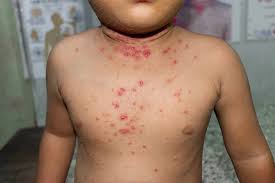Context:
The Democratic Republic of the Congo (DRC) is currently facing its largest Mpox outbreak.
More on the News:
- The outbreak has seen increased transmission and genetic mutations in the Mpox (Monkey Pox) viral strain, leading to a surge in cases and fatalities.
- Since January, over 4,500 suspected Mpox cases and nearly 300 deaths have been reported in the DRC. It is more than triple the number of cases compared to the previous year.
- The outbreak has spread beyond Congo’s borders, with cases reported in the neighbouring countries.
- The severity and scale of the outbreak have led Congo to declare a health emergency nationwide.
- Congo faces challenges in vaccine and treatment availability. Efforts to procure vaccines from donor countries like Japan are underway, but progress remains slow.
The outbreak is occurring in a town where residents have minimal interaction with wildlife believed to be natural carriers of the disease.
- This suggests “a new phase of Mpox,” with mutations likely arising from sustained human transmission in the region.
Mpox or Monkeypox
Mpox, also known as monkeypox, is a zoonotic viral disease similar to smallpox.

- It was first discovered in 1958 in laboratory monkeys, the name “monkeypox.” hence
- It’s typically found in parts of Central and West Africa, but in 2022, there was a global outbreak with cases reported in many countries, including the United States.
Transmission:
Mpox primarily spreads through close contact with an infected person or animal.
- This can include direct contact with skin lesions, bodily fluids, or contaminated objects like bedding.
- In recent outbreaks, sexual transmission has become a significant mode of spread, particularly among men who have sex with men (MSM).
Kinds of Mpox:
There are two types of Mpox clades (Kinds):
- Clade 1 (more severe, 10% fatality rate) may be responsible for the Kamituga cases.
- Clade 2 (triggered the 2022 outbreak, over 99% survival rate).
Symptoms:
- Mpox typically starts with flu-like symptoms such as fever, headache, muscle aches, and fatigue.
- After a few days, a rash with bumps and blisters develops, often starting on the face and spreading to other parts of the body.
- The severity of symptoms can vary, but Mpox is generally milder than smallpox.
- Lesions in the case of the Congo outbreak are milder and primarily on the genitals, making diagnosis more challenging than in past outbreaks.
Diagnosis:
- Mpox is diagnosed using a PCR (polymerase chain reaction) test on a sample of fluid from a skin lesion.
Treatment:
- There is no specific treatment for Mpox, but the illness usually resolves on its own within a few weeks.
- Supportive care, such as pain medication and fluids, can help manage symptoms.
- There are antiviral medications available that may be used in severe cases.
About Zoonotic Diseases
Definition:
- Zoonotic diseases, also known as zoonoses, are illnesses caused by pathogens (such as bacteria, viruses, parasites, and fungi) that can spread between animals and humans.
Transmission:
- Direct contact with infected animals or their body fluids (e.g., saliva, blood, urine).
- Indirect contact with contaminated environments, such as soil, water, or surfaces.
- Vector-borne transmission through bites of infected insects or other arthropods.
- Consumption of contaminated food or water (foodborne or waterborne transmission).
- Inhalation of airborne particles containing infectious agents (airborne transmission).
Caused by:
Zoonotic diseases can be caused by a wide range of pathogens and can affect humans in different ways:
- Bacterial: Examples include anthrax, brucellosis, and Lyme disease.
- Viral: Examples include rabies, Ebola virus disease, and influenza.
- Parasitic: Examples include malaria, toxoplasmosis, and leishmaniasis.
- Fungal: Examples include histoplasmosis, ringworm, and cryptococcosis.
Prevention:
- Proper hygiene practices, such as handwashing after handling animals and before eating.
- Vaccination of animals against zoonotic diseases.
- Vector control to reduce the spread of disease-carrying insects.
- Food safety measures, including proper cooking and storage of animal products.

